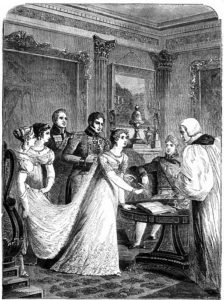 As you probably know by now, I love visiting National Trust properties. One of my favorite places to go is Claremont, near Esher. It’s an easy 20 minute drive from where I live, and it’s one of my go-to places when I want to go walking without having to drive too far. The grounds are beautiful and they are pretty much what they would have been like in 1813 when young Princess Charlotte Augusta, apparent heir to the Crown, moved there with her husband Prince Leopold of Saxe-Coburg.
As you probably know by now, I love visiting National Trust properties. One of my favorite places to go is Claremont, near Esher. It’s an easy 20 minute drive from where I live, and it’s one of my go-to places when I want to go walking without having to drive too far. The grounds are beautiful and they are pretty much what they would have been like in 1813 when young Princess Charlotte Augusta, apparent heir to the Crown, moved there with her husband Prince Leopold of Saxe-Coburg.
Princess Charlotte Augusta’s story has resonated with me since the first time I went to Claremont and came across this lonely memorial inscription at the top of the gardens.
The words were so stark and so full of despair, I wanted to find out more about this love story. Like many people, I knew very little about Princess Charlotte at the time. She is the Forgotten Princess.
 No one who lived during the Regency era could have imagined this would be her fate. It’s a comment on the futility of fame that she isn’t remembered any more. But at the time, she was wildly popular, so much so that, when she died in childbirth when she was 21, the whole country was grief-stricken.
No one who lived during the Regency era could have imagined this would be her fate. It’s a comment on the futility of fame that she isn’t remembered any more. But at the time, she was wildly popular, so much so that, when she died in childbirth when she was 21, the whole country was grief-stricken.
The reasons for her popularity were complicated. Some of it was because she was seen as a contrast to her father, the Prince Regent [later King George IV], who was generally disliked by everyone except his cronies. The newspapers and gossip columns were full of news about the way he treated her, keeping her in virtual isolation and limiting her access to her mother, Caroline of Brunswick. The Prince Regent hated his wife, to a large extent because his hand was forced by Parliament when they threatened to withhold his money if he didn’t get legally married [you probably already know the story of his ‘illegal’ marriage]. After the drunken honeymoon in which Charlotte was conceived, the Regent discarded his wife, wrote her out of his will, and eventually did everything he could to annul the marriage.
Another reason for her popularity was that the romance between her and Prince Leopold captured the nation’s imagination. In this story, too, the Prince Regent featured as the villain. The Princess fell in love with Leopold in 1814 when she was 18, but the Prince Regent had arranged another marriage for her – to Prince William of Orange, who was dubbed ‘Silly Billy’ because of his incompetence on the battlefield. Charlotte refused categorically, and her mother, Princess Caroline, rallied people’s support against the marriage.
Things came to a head when the Regent confined Charlotte to Cranbourne Lodge and controlling the number of people who could visit her. She ran away and had to be rescued by a man who helped her find a carriage. Her plight stirred the sympathy of the population at large. It was widely discussed in newspapers and became fodder for the opposition. The Regent quarrelled with his brother, Prince Augustus, Duke of Sussex [sound familiar? – history repeating itself] after the Duke raised the issue in the House of Lords. The two brothers never spoke to each other after that.
Fortunately, the Regent relented, but only after William of Orange got married. In 1816 Princess Charlotte was able to marry her prince. He was a popular choice. A huge crowd gathered at Claremont before the wedding when Prince Leopold was hosting a dinner, and the next day they surrounded his carriage as he made his way to Carlton House.

Wedding Princess Charlotte and Leopold Coburg
For a little over a year, it was happily ever after. She wrote the following:
“A Princess never, I believe, set out in life (or married) with such prospects of happiness, real domestic ones like other people.”

Claremont House home of Princess Charlotte and later of Queen Victoria as a child
They moved into Claremont House and immediately set out to make improvements to the neglected estate. All reports indicate they were very well-liked by the local population. Princess Charlotte made a consorted effort to employ people from the local villages, use local products, and take an interest in the local children and schools. This added to Charlotte’s popularity.
Then disaster struck. After more than 40 hours of labor, during which Leopold [unusually for a man of that era] was at her bedside, she delivered a still-born child. Leopold, relieved that his beloved wife had survived even if the baby sadly had not, went to bed. He was awakened a few hours later to discover she had died. To compound the tragedy, the accoucheur who was in attendance during the birth, Sir Richard Croft, committed suicide soon after.
Her funeral has been compared to Princess Diana’s. Like Diana, she was described as ‘the people’s princess.” During the service at St Paul’s Cathedral, so many people crowded around and tried to get in that they broke the gates and a few windows. Lord Byron, who was in Venice at the time, wrote that the “death of the Princess Charlotte has been a shock even here, and must have been an earthquake at home.”
For the first time in history, official Court mourning clothes were dictated by the Lord Chamberlain. Thousands of memento mori objects commemorating her death were sold, from coins and candlesticks to cups and saucers.
The couple were planning to build a summer house in the location of the memorial in the picture. It overlooked the grass auditorium and the lake, her favorite view. 
Instead, Prince Leopold built a mausoleum there. It was located in that area at the back in the picture below. You can see the foundations in the background. Sadly, the building was made of brittle materials and did not survive the test of time.

Leopold was devastated by Charlotte’s death. Lady Shelly wrote: “He spends some hours every day in the bedchamber of Princess Charlotte. That apartment is still as it was when the Princess left it the day before she died! Her pelisse, her boots, and even her hat, which she had carelessly thrown aside on the sofa, are left just as they were, for no one but the heart-broken Prince has entered that room. It is a case of real grief, and absolutely without parade.”

Princess Charlotte’s Mausoleum
He did not re-marry for ten years, when as King of the Belgiums he needed to produce an heir. Later, in his sixties, he wrote to Queen Victoria, who often stayed at Claremont as a child.
‘November, 1817, saw the ruin of this happy home, and the destruction, at one blow, of every hope and happiness.”
Princess Charlotte and her husband Prince Leopold may be largely forgotten to us. Still, the estate they established lives on, giving joy to thousands each year.

Spring in Claremont
~~~~
Princess Charlotte was a headstrong rebel who was openly defiant against her upbringing. If you want to find out more about Princess Charlotte’s hoydenish ways, you can check out this article by Abigail Reynolds.
You can read more about how Princess Charlotte’s death established new rules for mourning clothes in this article.

11 comments
Skip to comment form
Very interesting! Thanks for sharing that story.
Author
A pleasure, Jennifer! I find it fascinating.
I enjoyed this immensely, Monica! I love your personal stories of visits to exactly the kinds of places I’d love to visit, complete with really beguilingly presented historical background. A real pleasure.
Author
Thank you, Diana. That’s a great compliment coming from you, the master/mistress storyteller!!
Fascinating! I can’t get the second link to work to read more. Imagine if she had been Queen instead of Victoria. It’s interesting to imagine where history could have gone if this or that had (or hadn’t) happened. Thanks for the article!
Author
Yes, that’s what’s so fascinating about it, Bats. History would have been very different…
Author
Here’s the link to the article. If you can’t find it, you can search for The Madcap Princess Charlotte by Abigail Reynolds, who includes Princess Charlotte in her book (but doesn’t include the romance) https://austenvariations.com/the-other-princess-charlotte-2/
Am not one to read so I do not know this story. Heart-breaking story. Am drawing some inspiration from Princess Charlotte, her fortitude and demeanor despite all her struggles. Thank you for sharing
Author
Yes, that’s what I thought. She was a strong-minded person. Too bad she never had a chance to prove it.
Monica, thank you so much for sharing this intriguing piece of history! Your post has helped me imagine Elizabeth and Darcy discussing these events (both the joyous and the tragic) during the early years of their marriage.
Author
Thank you, Christina! We have some remarks in a letter by Jane Austen about Charlotte’s mother and the Prince Regent’s bad treatment of her. Like a lot of people, she really didn’t like him and sided with Caroline of Brunswick. And she was familiar with Claremont House. But that’s for another post. 😉